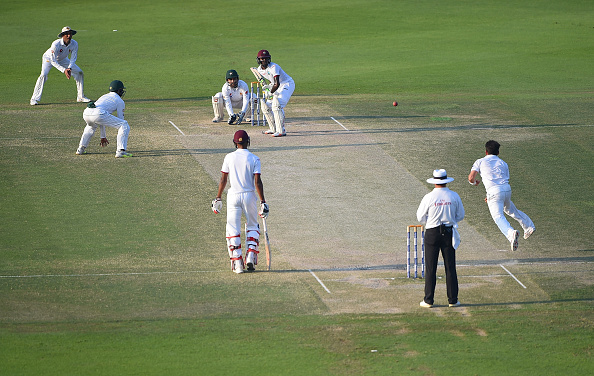As England struggle against spin in India, Garfield Robinson offers a surprising insight into why some accepted truths may be causing the problem
West Indies batsman Roston Chase was batting serenely on 31 during the second innings of the first Test against Pakistan at the Dubai International Cricket Stadium.
The hazard of facing Yasir Shah on a gripping fifth-day surface was exacerbated by the rough that had long developed outside the right-hander’s leg-stump. The Pakistani leg-break bowler was doing his best to exploit the disturbed area. The batsman was doing his best to cope.
Shah aimed for the rough and found it; Chase made a sizable stride to leg and smacked the ball through the midwicket area for four. “Playing the shot against the spin!” exclaimed one commentator on television. “Chase dares to go against the turn,” one text commentator wrote. “How’s that for audacity?” went another.
Next ball the batsman attempted a similar shot to a delivery in the same vicinity. He was bowled.
His wicket was seen as justification for the scepticism surrounding the wisdom of his previous shot. But the shot was risky, I’d submit, not because it was played against the spin; rather, the hazard rested in the fact that with the ball landing on the rough area, it was impossible to predict its degree of turn and height of bounce. The shot therefore could not have been played with any reasonable level of certainty.
Cricket experts are often heard chastising batsmen for playing against the spin. This is always held as dangerous and inadvisable. The right-handed batsman, for example, is encouraged to play the ball turning from off onto the leg-side. Hitting such a delivery back to off is to court danger. And pity the unfortunate batsman who gets out flouting this precept.
To consistently play against the spin is to violate cricketing orthodoxy. Pundits and experts often look askance at batsmen committing this transgression and coaches often berate their charges for doing it.
One highly regarded coaching website, offering useful tips and often featuring elite players giving instructions, dispensed this counsel: “If the ball is turning in (off-spin to a right handed batsman); the best areas to score are between mid-off and midwicket. If you keep an open body position with your hips towards the target area the swing of the bat can be straight. It’s safe because you are accounting for the ball turning back into you (playing with the spin)…Driving wide on the offside is more dangerous because you are playing against the spin.
“For the ball turning away, the danger changes and so does the scoring area. Now you would look to drive from straight to cover. The wider the line of bowling, the wider you can direct the ball safely.”
Nothing out of the ordinary there. Most aficionados would agree with those instructions. These are simply traditional theories passed from one generation to the next, that have assumed a veil of truth. So widely accepted are they as to be long regarded as cricketing science.
But theories can be debunked or expanded. History is replete with concepts held to be true, only to have been disproven, or, in some cases, to discover they have some additional dimension not previously contemplated.
Playing with the turn might just be slightly more dangerous than playing against it. Consider this: to play the off-spinner to the leg-side, which is to say with the spin, is to play across the line; while playing him back into the offside, or against the spin, is to meet the ball with the face of the bat, and more likely a safer way to play. In presenting the full face the batsman has the greatest chance of finding the middle of the bat.
Brian Lara scored 688 runs at 114.66 in a three-Test series against Sri Lanka and Muttiah Muralitharan in 2001/2002. After the tour he revealed some advice received from Sir Garfield Sobers. Lara sought the great man’s counsel prior to the visit and was advised that he should play the off-spinner “back to where he was coming from.” In other words, Sobers told him to play against the spin.
To be sure, Lara is one of the best batsmen the game has seen and, with his wide range, aggressive intent, and precise footwork, was rightly viewed as being adept at handling spin. But if he thinks he was made even better by Sobers’ guidance then who are we to disagree? Murali, incidentally, thinks the left-hander the best batsman’s he faced.
In his book, Behind The Shades, Duncan Fletcher, the highly regarded former England and Indian coach, tells of an incident, also in Sri Lanka, where Graham Thorpe was striving to decipher the puzzles presented by Muralitharan. With Thorpe being a left-hander, Murali’s stock delivery would have been turning from leg to off.
“Thorpe’s initial theory, based on previous advice, was that he needed to close himself off in his stance and look to hit the ball through the off side, even though, as we said, Murali was pitching the ball on or outside the leg stump. I told him to think about how he could hit the ball back where it spins from, hitting a straight ball with a straight bat. The answer was to open up his stance and hit to the leg side with a straight bat. That might seem like hitting against the spin to old-timers, but the laws of geometry will back me up to prove that he was, in fact, playing a straight ball.”
The advice Fletcher gave Thorpe was similar to that which Sobers offered to Lara. And if their success against the Sri Lankan magician is anything to go by, the advice seemed to have been helpful. What this means is that batsmen, over the years, might not have been well served by this long accepted method of negotiating spin bowling. Perhaps, therefore, coaches should no longer frown when they observe batsmen playing against the spin.
“Hitting a straight ball with a straight bat,” as Fletcher advocated, is what the coaching manual has always instructed. Playing the ball turning from off, to the leg-side does not follow that guideline.
There is no doubt that batsmen are required to play both with and against the turn, especially when confronting a good spinner. But playing against the spin should not, as it frequently is, be thought of as reckless.
It just might be the better way.
This piece originally featured in The Cricket Paper, December 16 2016
Subscribe to the digital edition of The Cricket Paper here















